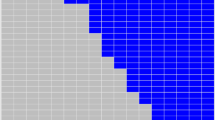Abstract
With a 26-year-long database of nationally distributed movies, we estimate the prevalence and effectiveness of sequels over time, while controlling for other factors that might influence demand. In particular, we examine whether the effectiveness of a strategy increases over time (possibly due to managerial learning) or decreases (possibly because its effectiveness is competed away or because of consumer satiation). After taking into account both supply side and demand side effects by using simultaneous equations, we find that sequels have a positive effect indirectly (i.e., supply side effect) through a significantly larger number of theaters showing such movies compared to non-sequel movies. In terms of direct effect (i.e., demand side effect), sequels do better than non-sequels in generating more attendance in the first week and in total. Parent movies, the movies from which sequels originate, also do better than non-sequels in terms of total attendance and first-week attendance. Interestingly, sequel movies generate less total attendance than parent movies. On the other hand, sequels generate more revenues upfront than parents. We also find that the impact of sequels on first-week attendance has been increasing over time, but the number of sequels released has not. Our follow-up analysis suggests that one reason can be due to the higher (inflation-adjusted) production budget of a sequel than of the original (i.e., the parent) movie possibly leading to a decreasing gross margin for sequels within a movie franchise.


Similar content being viewed by others
Notes
When we ran a regression of the number of sequels made each year as a function of a yearly time trend, we found no significant (p < 0.05) relationship with time. For non-sequels, the coefficient of time was significant.
Studies 1–5 in Table 1 used essentially the same sample. However, due to different model specifications and statistical approaches, different results for sequels were reported.
In our sample, on average, sequels ran for 12 weeks, parents of the sequels ran for 15 weeks, and the rest of the movies ran for 10 weeks.
Detailed Hausman test results are available from the authors.
Detailed tables of descriptive statistics are available from the authors.
Detailed test results are available from the authors.
References
Aaker, D. A., & Keller, K. L. (1990). Consumer evaluations of brand extensions. Journal of Marketing, 54(1), 27–41.
Ainslie, A., Drèze, X., & Zufryden, F. (2005). Modeling movie life cycles and market share. Marketing Science, 24(3), 508–517.
Basuroy, S., & Chatterjee, S. (2008). Fast and frequent: Investigating box office revenues of motion pictures sequels. Journal of Business Research, 61, 798–803.
Basuroy, S., Chatterjee, S., & Ravid, S. A. (2003). How critical are critical reviews? The box office effects of film critics, star power and budgets. Journal of Marketing, 67(4), 103–117.
Basuroy, S., Desai, K., & Talukdar, D. (2006). An empirical investigation of signaling in the motion picture industry. Journal of Marketing Research, 43, 287–295.
Dekimpe, M., & Hanssens, D. (1995). The persistence of marketing effects on sales. Marketing Science, 14(1), 1–21.
Einav, L. (2007). Seasonality in the U.S. motion picture industry. The Rand Journal of Economics, 31(1), 127–145.
Elberse, A., & Eliashberg, J. (2003). Demand and supply dynamics for sequentially released products in international markets: The case of motion pictures. Marketing Science, 22(3), 329–354.
Eliashberg, J., Elberse, A., & Leenders, M. A. A. M. (2006). The motion picture industry: Critical issues in practice, current research, and new research directions. Marketing Science, 25(6), 638–661.
Greene, W. H. (2003). Econometric analysis (5th ed.). Upper Saddle River: Prentice Hall.
Hennig-Thurau, T., Houston, M., & Heitjans, T. (2009). Conceptualizing and measuring the monetary value of brand extensions: The case of motion pictures. Journal of Marketing, 73(4), 167–183.
Hennig-Thurau, T., Houston, M., & Walsh, G. (2006). The Differing Roles of Success Drivers Across Sequential Channels: An Application to the Motion Picture Industry. Journal of the Academy of Marketing Science, 34(4), 559–575.
Ho, J., Dhar, T., & Weinberg, C. (2009). Playoff payoff: Super bowl advertising for movies. International Journal of Research in Marketing, 26(2), 168–179.
Holbrook, M., & Addis, M. (2007). Taste versus the market: An extension of research on the consumption of popular culture. Journal of Consumer Research, 24(3), 415–424.
Krider, R., Li, T., Liu, Y., & Weinberg, C. (2005). The lead-lag puzzle of demand and distribution: A graphical method applied to movies. Marketing Science, 24(4), 635–645.
Lazear, E. (2004). The Peter principle: A theory of decline. Journal of Political Economy, 112(1), s141–s163.
Palia, D., Ravid, S. A., & Reisel, N. (2008). Choosing to cofinance: Analysis of project-specific alliances in the movie industry. Review of Financial Studies, 21(2), 483–511.
Raut, S., Swami, S., Lee, E., & Weinberg, C. (2008). How complex do movie contracts need to be? Marketing Science, 27(4), 627–641.
Ravid, S. (1999). Information, blockbusters, and stars: A study of the film industry. Journal of Business, 72(4), 463–492.
Ravid, S., & Basuroy, S. (2004). Managerial objectives, the R-rating puzzle, and the production of violent films. Journal of Business, 77(2), S155–S192.
Sawhney, M. S., & Eliashberg, J. (1996). A parsimonious model for forecasting gross box-office revenues of motion pictures. Marketing Science, 15(2), 113–131.
Sood, S., & Drèze, X. (2006). Brand extensions of experiential goods: Movie sequel evaluations. The Journal of Consumer Research, 33(3), 352–360.
Wilkinson, J., Mason, J., & Paksoy, C. (1982). Assessing the impact of short-term supermarket strategy variables. Journal of Marketing Research, 19(2), 72–86.
Acknowledgments
The financial support of the Social Sciences and Humanities Research Council of Canada is gratefully acknowledged. Helpful comments from Darren Dahl and Josh Eliashberg are much appreciated.
Author information
Authors and Affiliations
Corresponding author
Electronic supplementary materials
Below is the link to the electronic supplementary material.
ESM 1
(DOCX 56 kb)
Rights and permissions
About this article
Cite this article
Dhar, T., Sun, G. & Weinberg, C.B. The long-term box office performance of sequel movies. Mark Lett 23, 13–29 (2012). https://doi.org/10.1007/s11002-011-9146-1
Published:
Issue Date:
DOI: https://doi.org/10.1007/s11002-011-9146-1




